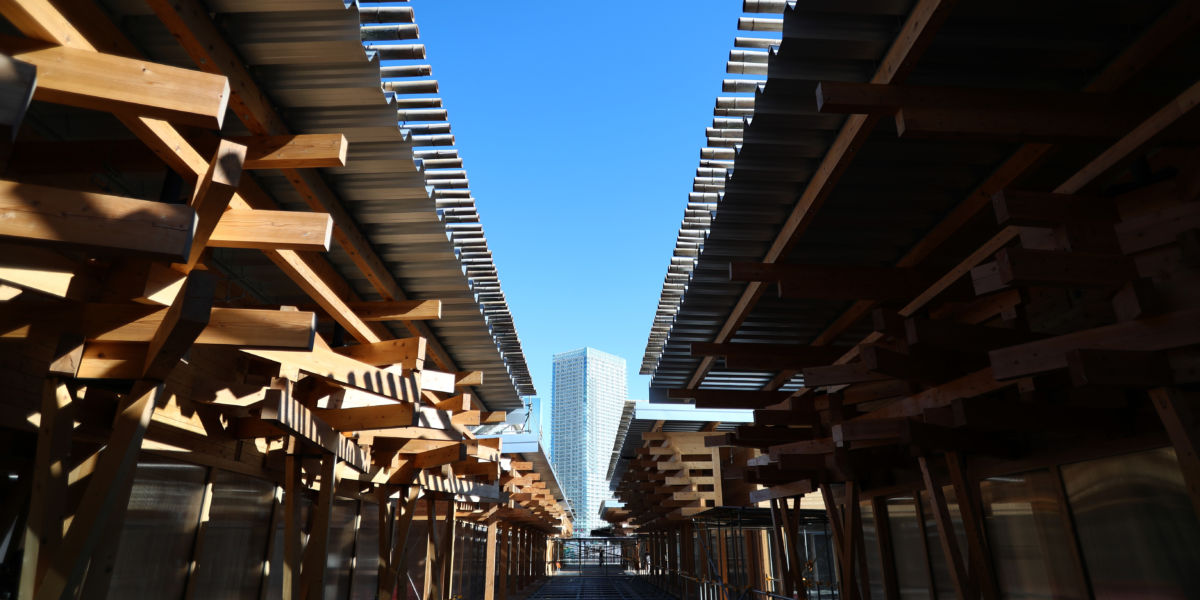
Japan Used Sustainable Timber to Build for the Olympics. Here’s How to Incorporate it into Your Own Home
In a radical departure from the towering concrete-and-steel buildings that fill the city’s skyline, many of the facilities built for the Tokyo Olympics are constructed from wood—a material that holds ancient history and new promise for Japanese architects.

Among the many reasons why it’s disappointing that spectators won’t be allowed to watch this summer’s Olympic Games is that fewer people will be able to appreciate the feats of engineering accomplished by local architects who built facilities largely out of locally harvested, sustainable timber for the event. Kengo Kuma, one of the country’s most prominent architects, and the designer behind the new 68,000-seat National Stadium, has said the buildings symbolize a “new period of natural design” and the symbolic end of concrete. The stadium has been described as a timber temple, with a lattice of beams and joists to support its roof.
Planters filled with lush greenery line its three levels of walkways, and the open-air stadium references ancient pagodas and traditional Japanese wooden architecture.
Here’s the coolest part: The structure was built with cedar sourced from more than 60 communities located in all 47 of Japan’s prefectures. And the number 47 has a special significance: The structure is 47.4 meters high, and 47,000 trees have been planted in the surrounding area. It’s a stark contrast to other massive concrete and steel structures nearby.
After the Great Kanto earthquake in 1923 leveled hundreds of thousands of homes and buildings, and much of what remained standing was consumed by fires, the country turned to concrete as its primary building material. And that trend continued when the nation was forced to rebuild after World War II. Some of the most radical and impressive concrete structures in the world designed by visionary architects like Le Corbusier and Tadao Ando are here.
But many modern-day architects fear that the country’s connection to nature, both spiritually and culturally, got lost in all of this Brutalist and modernism fever. Shinto, the religion that originated in Japan, holds sacred beliefs around trees: Any tree that’s more than 100 years old is inhabited by spirits known as kodama. In traditional architecture, wood is left unpainted as a sign of appreciation and respect for its natural beauty. Forest bathing, the practice of taking cleansing walks through the woods, originated in Japan in the 1980s. And the country’s most significant shrines, including the 2,000-year-old Ise Jingu that’s torn down and rebuilt every 20 years, are made of wood.
Japanese Olympics officials and a committee of celebrated local architects were focused on channeling those ideas, the impermanence and beauty of the natural world, into the Olympic village and new stadiums.

Clive Rose for Getty Images
Under forest management and guidance (after some early controversy questioning the sources of the wood and the actual sustainability of the projects), several sustainable timber constructions were completed in advance of the Games. That includes “Operation BATON,” which stands for Building ‘Athlete’s Village’ with the Timber of the Nation, plus the Athlete’s Village Plaza. The 40,000 pieces of wood used to create the plaza will be re-used, once it’s disassembled. The Ariake gymnastic stadium was made from 24,000 square feet of timber and has one of the largest wooden roofs in the world. Olympics representatives in Japan have said that some of the wood will be returned to the prefectures where it originated (many of the planks and boards have been stamped with their origin) after they’re no longer in use and used to build structures commemorating the games.
Interested in learning more about sustainable timber? Check out Think Wood or the NRDC Good Wood guide for more information before your next home building or remodeling project. Look for the seal of Rainforest Alliance or Forest Stewardship Council certification when you’re buying new wood furniture. And shop from brands like West Elm and Crate and Barrel, which have increased their focus on responsible retail practices and environmental initiatives. Buy second-hand whenever possible.
If you’re curious about how commercial mass timber buildings—like this college dorm in Arkansas—are taking off here in the states, too, check out this list of USDA Tall Wood Building Prize Winners. And click here to learn about cross-laminated timber (CLT), an innovative new type of building material that’s starting to have a real impact on construction and renovation in the West.
